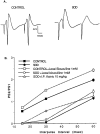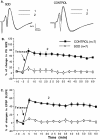Upregulation of GABA neurotransmission suppresses hippocampal excitability and prevents long-term potentiation in transgenic superoxide dismutase-overexpressing mice
- PMID: 10594078
- PMCID: PMC6784966
- DOI: 10.1523/JNEUROSCI.19-24-10977.1999
Upregulation of GABA neurotransmission suppresses hippocampal excitability and prevents long-term potentiation in transgenic superoxide dismutase-overexpressing mice
Abstract
Cu/Zn superoxide dismutase (SOD-1) is a key enzyme in oxygen metabolism in the brain. Overexpression of SOD-1 in transgenic (Tg) mice has been used to study the functional roles of this enzyme in oxidative stress, lipid peroxidation, and neurotoxicity. We found that Tg-SOD-1 mice are strikingly less sensitive to kainic acid-induced behavioral seizures than control mice. Furthermore, the hippocampus of Tg-SOD-1 mice was far less sensitive to local application of bicuculline, a GABA-A antagonist, than the hippocampus of control mice. GABAergic functions, expressed in extracellular paired-pulse depression, and in IPSCs recorded in dentate granular cells were enhanced in Tg-SOD-1 mice. Finally, long-term potentiation (LTP), not found in the dentate gyrus of Tg-SOD-1 mice, could be restored by local blockade of inhibition and could be blocked in control mice by injection of diazepam, which amplifies inhibition. These results indicate that constitutive elevation of SOD-1 activity exerts a major effect on neuronal excitability in the hippocampus, which, in turn, controls hippocampal ability to express LTP.
Figures









Similar articles
-
Paradoxical actions of hydrogen peroxide on long-term potentiation in transgenic superoxide dismutase-1 mice.J Neurosci. 2003 Nov 12;23(32):10359-67. doi: 10.1523/JNEUROSCI.23-32-10359.2003. J Neurosci. 2003. PMID: 14614095 Free PMC article.
-
Reversible impairment of long-term potentiation in transgenic Cu/Zn-SOD mice.Eur J Neurosci. 1998 Feb;10(2):538-44. doi: 10.1046/j.1460-9568.1998.00058.x. Eur J Neurosci. 1998. PMID: 9749716
-
DNA fragmentation and Prolonged expression of c-fos, c-jun, and hsp70 in kainic acid-induced neuronal cell death in transgenic mice overexpressing human CuZn-superoxide dismutase.J Cereb Blood Flow Metab. 1997 Mar;17(3):241-56. doi: 10.1097/00004647-199703000-00001. J Cereb Blood Flow Metab. 1997. PMID: 9119897
-
GABAB receptor- and metabotropic glutamate receptor-dependent cooperative long-term potentiation of rat hippocampal GABAA synaptic transmission.J Physiol. 2003 Nov 15;553(Pt 1):155-67. doi: 10.1113/jphysiol.2003.049015. Epub 2003 Sep 8. J Physiol. 2003. PMID: 12963794 Free PMC article.
-
Functional and morphological alterations in compound transgenic mice overexpressing Cu/Zn superoxide dismutase and amyloid precursor protein [correction].Eur J Neurosci. 2004 Mar;19(5):1174-90. doi: 10.1111/j.1460-9568.2004.03188.x. Eur J Neurosci. 2004. PMID: 15016076
Cited by
-
Impairment of long-term potentiation and associative memory in mice that overexpress extracellular superoxide dismutase.J Neurosci. 2000 Oct 15;20(20):7631-9. doi: 10.1523/JNEUROSCI.20-20-07631.2000. J Neurosci. 2000. PMID: 11027223 Free PMC article.
-
Hydrogen peroxide as a diffusible signal molecule in synaptic plasticity.Mol Neurobiol. 2004 Apr;29(2):167-78. doi: 10.1385/MN:29:2:167. Mol Neurobiol. 2004. PMID: 15126684 Review.
-
Inflammation subverts hippocampal synaptic plasticity in experimental multiple sclerosis.PLoS One. 2013;8(1):e54666. doi: 10.1371/journal.pone.0054666. Epub 2013 Jan 23. PLoS One. 2013. PMID: 23355887 Free PMC article.
-
A knock-in reporter model of Batten disease.J Neurosci. 2007 Sep 12;27(37):9826-34. doi: 10.1523/JNEUROSCI.1710-07.2007. J Neurosci. 2007. PMID: 17855597 Free PMC article.
-
Suppression of neuronal hyperexcitability and associated delayed neuronal death by adenoviral expression of GABA(C) receptors.J Neurosci. 2001 May 15;21(10):3419-28. doi: 10.1523/JNEUROSCI.21-10-03419.2001. J Neurosci. 2001. PMID: 11331372 Free PMC article.
References
-
- Amstad P, Peskin A, Shah G, Mirault ME, Moret R, Zbinden I, Cerutti P. The balance between CuZn-superoxide dismutase and catalase affects the sensitivity of mouse epidermal cells to oxidative stress. Biochemistry. 1991;30:9305–9313. - PubMed
-
- Avraham KB, Schickler M, Sapoznikov D, Yarom R, Groner Y. Down's syndrome: abnormal neuromuscular junction in tongue of transgenic mice with elevated levels of human Cu/Zn-superoxide dismutase. Cell. 1988;54:823–829. - PubMed
-
- Ben-Ari Y. Limbic seizure and brain damage produced by kainic acid: mechanisms and relevance to human temporal lobe epilepsy. Neuroscience. 1985;14:375–403. - PubMed
-
- Chan PH, Chu L, Chen SF, Carlson EJ, Epstein CJ. Reduced neurotoxicity in transgenic mice overexpressing human copper-zinc-superoxide dismutase. Stroke. 1990;21:11180–11182. - PubMed
Publication types
MeSH terms
Substances
LinkOut - more resources
Full Text Sources
Other Literature Sources
Molecular Biology Databases
Miscellaneous
